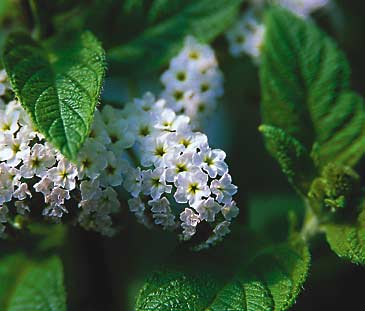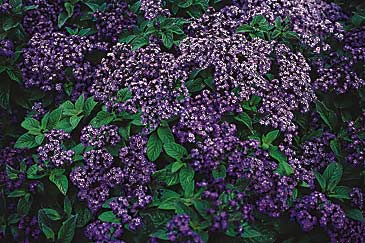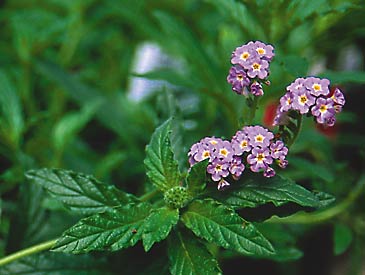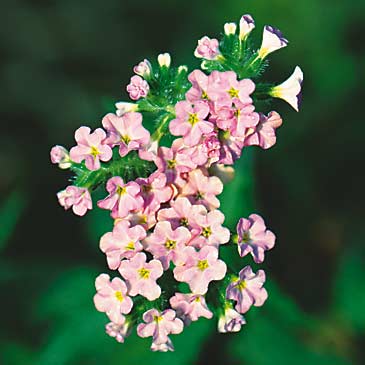 Jonathon Hofley / Michigan Gardener
Jonathon Hofley / Michigan Gardener
‘Alba’by George Papadelis
Heliotrope continues to be one of the most sought after annual plants every spring. Some varieties have intoxicating, vanilla-scented flowers that are irresistible, while others have beautiful blue, white, or lavender flowers. Its potent fragrance earned it the common name “cherry pie,” however, I have never heard anyone suggest that the scent even remotely conjures hints of any kind of pie. Heliotrope “flowers” are actually clusters of 1/4-inch blooms that develop in masses to form 4- to 8-inch heads. Among gardeners, the purple-blue varieties are the most desirable for their flowers, which combine so well with shades of pink, silver, or gold.
The rich, velvety flowers have become more and more popular in container gardens. Even the gardeners of the Victorian period recognized its value in potted combinations. Now that the huge, trailing leaves of golden sweet potato vine have made it into the container plant spotlight, heliotrope has been revealed as one of its perfect partners. Deep green heliotrope leaves and rich blue flowers above the golden leaves of sweet potato vine—wow! Add a trailing pink verbena or ivy geranium and you have a truly vibrant display.
Heliotrope is also a wonderful plant for bedding. One of my fondest heliotrope memories is a stunning combination I saw at the beautiful Butchart gardens in British Columbia about 10 years ago. Heliotrope was alternated in a mass planting with the variegated leaf geranium ‘Mrs. Parker.’ The cream and green leaves of the geranium shined beautifully below the bright pink geranium blooms and deep blue heliotrope flowers; it was breathtaking! In this example, even heliotrope’s dark green leaves were used to contrast with other foliage.
 Johnny’s Selected Seeds
Johnny’s Selected Seeds
‘Marine’The most popular heliotrope is a readily available, seed-grown variety called ‘Marine.’ It is only slightly fragrant but has the navy blue flowers for which heliotrope is so commonly praised. It grows 15 to 18 inches tall. Because it is seed grown, it is usually the easiest for growers to produce and therefore the most inexpensive heliotrope to buy.
A cutting-grown variety called ‘Atlantis’ is rapidly becoming more popular. The flowers are about the same as ‘Marine’ but the plant seems to be more resistant to stretching. This makes it more desirable in situations where crowding (and thus stretching) might occur.
 EuroAmerican Propagators
EuroAmerican Propagators
‘Azure Skies’The variety ‘Nagano’ is arguably the most fragrant blue heliotrope. The flowers emit a baby-powder scent that is strongest in the evening. It has the more compact growth habit of ‘Atlantis’ but sports deep violet-blue flowers.
In my opinion, the most fragrant variety is the white cultivar called ‘Alba.’ I know very little about aromatherapy, but I can’t imagine life without experiencing nature’s most pleasant scents. To remove a flower and enjoy its fragrance for even a few minutes is well worth the space required to grow this plant. White heliotrope’s vanilla scent is rivaled by few flowers; jasmine and English roses come to mind. This is an attractive plant but it is rarely grown for its beauty alone.
One of the newest varieties is a unique trailing version called ‘Azure Skies.’ Oddly, this one has no fragrance and grows more horizontally rather than upright. Its lavender flowers can be used to trail over the edge of a pot or it may be used for bedding as a low spreading mound about 8 inches tall.
 Jonathon Hofley / Michigan Gardener
Jonathon Hofley / Michigan Gardener
‘Azure Skies’All heliotrope prefer full or partial sun and all thrive in well-drained soils. Plants grown too cold or too wet can develop root rots. That being said, don’t allow plants to dry out. They are occasionally attacked by aphids but insecticidal soap can solve that problem.
Heliotrope can offer beautiful flowers as well as incredible fragrance. Once you have decided how you are going to use it, all you have to do is choose the appropriate variety. If you have never planted heliotrope and you don’t intend to have it in your garden, hopefully you will encounter it some day and experience its remarkable fragrance.
George Papadelis is the owner of Telly’s Greenhouse in Troy, MI.
